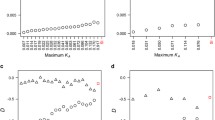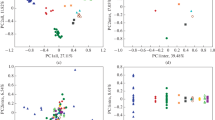Abstract
Seven populations ofDrosophila melanogaster, representing a worldwide distribution, were compared using two-dimensional protein gel electrophoresis. A total of 611 protein spots was scored, which probably represent a sample of over 500 loci that were surveyed. Of the protein spots scored, 521 spots were found to be invariant, but another 90 spots were found to be variable among the populations. Of these variable protein spots, 12 were found to be present in only one population. All the populations, except one, had at least one protein spot restricted to itself. However, the Japanese population had by far the most, with five protein spots restricted to this one population, which has been observed in previous studies of private alleles in oriental populations. The mean genetic similarity (F) found among the seven populations was 0.965, with a range of between 0.956 and 0.977. This is similar to previous reports of lower variation found in population genetic surveys using two-dimensional electrophoresis. It was found that the historical relationships among these populations was somewhat congruent with the geographic distribution of the populations, but as in previous studies, it was not exactly coincident.
Similar content being viewed by others
References
Anderson, N. L. (1988).Two-Dimensional Electrophoresis. Operation of the ISO-DALT System Large Scale Biology Press, Washington, D.C.
Anderson, N. G., and Anderson, N. L. (1978). Analytical techniques for cell fractions. XXI. Two-dimensional analysis of serum and tissue proteins: multiple isoelectric focusing.Anal. Biochem. 85331.
Aquadro, C. F., and Avise, J. C. (1981). Genetic divergence between rodent species assessed by using two-dimensional electrophoresis.Proc. Natl. Acad. Sci. 783784.
Avise, J. C., Arnold, J., Ball, R. M., Bermingham, E., Lamb, T., Neigel, J. E., Reeb, C. A., and Saunders, N. C. (1987). Intraspecific phylogeography: The mitochondrial DNA bridge between population genetics and systematics.Annu. Rev. Syst. Ecol. 18489.
Coulthart, M. B., and Singh, R. S. (1988a). Differing amounts of genetic polymorphism in testes of male accessory glands ofDrosophila melanogaster andDrosophila simulans.Biochem. Genet. 26153.
Coulthart, M. B., and Singh, R. S. (1988b). Low genic variation in male-reproductive-tract proteins ofDrosophila melanogaster andD. simulans.Mol. Biol. Evol. 5167.
Coulthart, M. B., and Singh, R. S. (1988c). High level of divergence of male-reproductive-tract proteins, betweenDrosophila melanogaster and its sibling species,D. simulans.Mol. Biol. Evol. 5182.
Coyne, J. A., and Milstead, B. (1987). Long-distance migration ofDrosophila. 3. Dispersal ofD. melanogaster alleles from a Maryland orchard.Am. Nat. 13070.
Dice, L. R. (1941). Measures of the amount of ecologic association between species.Ecology 26297.
Felsenstein, J. (1985). Confidence limits on phylogenies: an approach using the bootstrap.Evolution 39783.
Guevara, J., Johnston, D. A., Ramagali, L. S., Martin, B. A., Capetillo, S., and Rodriguez, L. V. (1982). Quantitative aspects of silver deposition in proteins resolved in complex polyacrylamide gels.Electrophoresis 3197.
Hale, L. R., and Singh, R. S. (1986). Extensive variation and heteroplasmy in size of mitochondrial DNA among geographic populations ofDrosophila melanogaster.Proc. Natl. Acad. Sci. 838813.
Harrison, H. H. (1984). Improved record keeping and photography of silver-stained two-dimensional electrophoretograms by way of “XRD images.”Clin. Chem. 301981.
Hendy, M. D., and Penny, D. (1982). Branch and bound algorithms to determine minimal evolutionary trees.Math. Biosci. 59277.
Lee, C.-Y., Charles, D., Bronson, D., Griffen, M., and Bennett, L. (1979). Analyses of mouse andDrosophila proteins by two-dimensional gel electrophoresis.Mol. Gen. Genet. 174303.
Leigh Brown, A. J., and Langley, C. H. (1979). Reevaluation of genic heterozygosity in natural populations ofDrosophila melanogaster by two-dimensional electrophoresis.Proc. Natl. Acad. Sci. USA 762381.
Lewontin, R. C. (1974).Genetic Basis of Evolutionary Change Columbia University Press, New York.
Margush, T., and McMorris, F. R. (1981). Consensus n-trees.Bull. Math. Biol. 43239.
Mickevich, M. F., and Johnson, M. S. (1976). Congruence between morphological and allozyme data in evolutionary inference and character evolution.Syst. Zool. 25260.
Mickevich, M. F., and Mitter, C. (1981). Treating polymorphic characters in systematics: A phylogenetic treatment of electrophoretic data. In Funk, F. A., and Brooks, D. R. (eds.),Advances in Cladistics Allen Press, Lawrence, Kans., pp. 45–58.
Nei, M. (1972). Genetic distances between populations.Am. Nat. 106283.
O'Farrell, P. H. (1975). High resolution two-dimensional electrophoresis.J. Biol. Chem. 2504007.
Ohnishi, S., Leigh Brown, A. J., Voelker, R. A., and Langley, C. H. (1982). Estimation of genetic variability in natural populations ofDrosophila simulans by two-dimensional and starch gel electrophoresis.Genetics 100127.
Ohnishi, S., Kawanishi, M., and Watanabe, T. K. (1983). Biochemical phylogenies ofDrosophila: Protein differences detected by two-dimensional electrophoresis.Genetica 6155.
Prakash, S. (1977). Genetic divergence in closely related sibling speciesDrosophila pseudoobscura, Drosophila persimilis, andDrosophila miranda.Evolution 3114.
Racine, R. R., and Langley, C. H. (1980). Genetic heterozygosity in a natural population ofMus musculus assessed using two-dimensional electrophoresis.Nature 283855.
Rohlf, F. J. (1990).NTSYS-pc. Numerical Taxonomy and Multivariate Analysis System (ver 1.60), Exeter, Setauket, N.Y.
Sanderson, M. J. (1989). Confidence limits on phylogenies: The bootstrap revisited.Cladistics 5113.
Singh, R. S., and Rhomberg, L. R. (1987a). A comprehensive study of genic variation in natural populations ofDrosophila melanogaster. I. Estimates of gene flow from rare alleles.Genetics 115313.
Singh, R. S., and Rhomberg, L. R. (1987b). A comprehensive study of genic variation in natural populations ofDrosophila melanogaster. II. Estimates of heterozygosity and patterns of geographic differentiation.Genetics 117255.
Singh, R. S., Hickey, D. A., and David, J. (1982). Genetic differentiation between geographically distant populations ofDrosophila melanogaster.Genetics 101235.
Singh, R. S., Choudhary, M., and David, J. (1987). Contrasting patterns of geographic variation in the cosmopolitan speciesDrosophila melanogaster andDrosophila simulans.Biochem. Genet. 2527.
Sneath, P. H. A., and Sokal, R. R. (1973).Numerical Taxonomy W. H. Freeman, San Francisco.
Sokal, R. R., and Sneath, P. H. A. (1963).Principles of Numerical Taxonomy W. H. Freeman, San Francisco.
Spicer, G. S. (1988a). The effects of culture media on the two-dimensional electrophoretic pattern ofDrosophila virilis.Dros. Inf. Serv. 6774.
Spicer, G. S. (1988b). Molecular evolution among someDrosophila species groups as indicated by two-dimensional electrophoresis.J. Mol. Evol. 27250.
Spicer, G. S. (1991). Molecular evolution and phylogeny of theDrosophila virilis species group as inferred by two-dimensional electrophoresis.J. Mol. Evol. 33 (in press).
Swofford, D. L. (1990).PAUP. Phylogenetic Analysis Using Parsimony (ver 3.0n), Ill. Nat. Hist. Surv., Champaign.
Thorpe, P. A., and Dickinson, W. J. (1988). The use of regulatory patterns in constructing phylogenies.Syst. Zool. 3797.
Whitt, G. S. (1987). Species differences in isozyme tissue patterns: their utility for systematic and evolutionary analysis. In Rattazzi, M. C., Scandalios, J. G., and Whitt, G. S. (eds.),Isozymes: Current Topics in Biological and Medical Research, Vol. 10 Alan R. Liss, New York, pp. 1–26.
Author information
Authors and Affiliations
Rights and permissions
About this article
Cite this article
Spicer, G.S., Fleming, J.E. Genetic differentiation ofDrosophila melanogaster populations as assessed by two-dimensional electrophoresis. Biochem Genet 29, 389–401 (1991). https://doi.org/10.1007/BF00554145
Received:
Revised:
Issue Date:
DOI: https://doi.org/10.1007/BF00554145




